There are games that immediately hit you and others that need time to grow on you. Some that invite you by looking gorgeous and others that stop you from ever trying them out, simply by the way they look. And there are games that are chunky-complex and others that do not have enough meat on the bone to warrant repeated play. With so many new games coming out every month, it’s easy to go for the extremes, the most unique theme, the most unique artwork, etc.
As I played my 5th solo game of Messina 1347, there came a realisation that I was intuitively looking for something special in Messina. Lately, I try to curate my gaming collection more heavily. Shelf space is limited and time playing with a group rare and valuable. I enjoy making a conscious decision to give away or trade games that I think are good and invest more in games that I love. Sometimes that has strange results like buying Iron Clays for Brass: Birmingham (although I already have nice metal coins that work just fine) or getting the Suburbia Super Collector’s Edition (really, nobody NEEDS that many player colours, but it’s sure fun to have them). But overall, I’m very happy with this new trend of refining my collection.
In comes Messina 1347. Is it the greatest artwork I have ever seen? No. Production quality has gone to ridiculous levels lately, just look at the gorgeous artwork of Lost Ruins of Arnak, Brass: Birmingham or the characters in Red Rising. In contrast, Messina looks “just” nice. It’s well done and I enjoy it. Is it the most amazing theme? No, but it is intriguing. Does it have a mechanism you have never seen before? No, not fundamentally. So after my first play, I was unsure if it would stay in my collection for long. Funny enough, I told a few friends and I should have noticed something was going on when every single one told me “this looks really interesting, don’t sell it until we have played it!”.
However, as I wrote in the beginning, it took me until today to suddenly realise: I really, really enjoy this game!
Let me explain: The special thing I hadn’t been looking for is how well balanced this game is. And I don’t mean balanced in the sense of victory points, more like a good wine or meal where each flavour is in harmony. So let me talk you through the game.
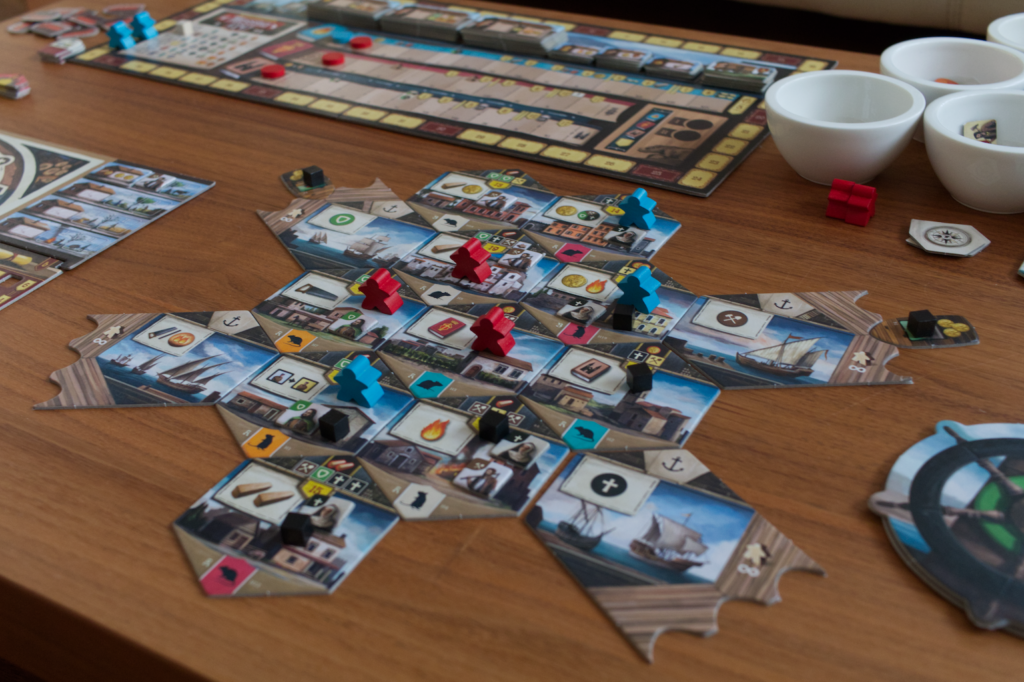
Setup
Setup is pleasantly easy: grab a player board, pick if you want to play with the standard A side or unique B side, sort a few tiles, shuffle the hex pieces and form the city of Messina. Use the included wheel to distribute the initial plague cubes and population, dock a ship and that’s pretty much it. The city of Messina is where you will be placing your worker meeples, fight the plague, rescue citizens, perform the action printed on the hex and – when the time is right – claim them by repopulating them. Your player board is where you keep rescued citizens in quarantine before they can be placed in various sectors to give you bonuses whenever you move one of your overseer discs on that board. A shared main board contains three tracks, a market of buildings you can purchase, a round indicator and the VP track. This is a bit oversimplified, but the gist is that setup is quick and the general concept of the game is easy to grasp.
Turn
The game is played over six rounds. When it’s your turn, move one of your worker meeples to a new location (or use the one you already stand on) and first rescue all citizens on that hex. If there is a plague token on the hex, the citizens go each into one of your four quarantine huts. Don’t have an empty hut available? Discard that citizen, he/she is lost. If there is no plague token on the hex, you can immediately place them into one of the empty squares on your player board. So is it better to rescue citizens from hexes with no plague? It depends: quarantined citizens are delayed, you have to wait two turns before being able to use them. But you can build upgraded huts where they can generate resources while in quarantine. Also: if you only go to places where the plague isn’t, you cannot use any fire tokens you gather to fight the plague, and fighting the plague allows you to move on the popularity track and give you nice bonuses. Option three: go to a hex token but don’t fight the plague. You get quarantined citizens (which might be profitable for work in your huts) and a rat token which will hurt your reputation at the end of the game but don’t have to waste actions on collecting fire tokens first. Regardless of whether or not you decide to fight the plague, citizens collected from such a hex field have to be quarantined.
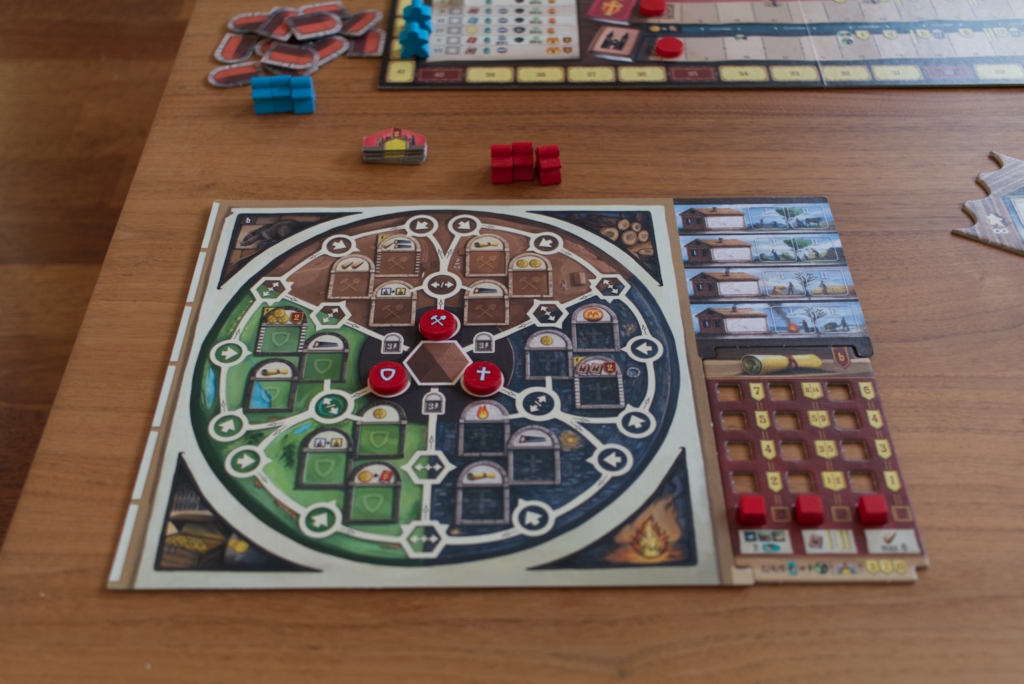
The tension tightens because only a limited amount of citizens are placed onto the board at the end of each turn and there are three types of citizens. So sometimes you want to fight the plague but there is no citizen on the hex. Or you don’t want to fight the plague but have the opportunity to pick up a large number of citizens at once. Or you cannot really use the action printed on the hex field but you desperately need to rescue that one nun because she can immediately start working for you.
Back to your turn: you move one of your worker meeples (paying gold if you have to move more than one field, so placement is relevant for future turns), rescue the citizens, decide if you want to fight the plague, perform the action (or later on skip it to instead repopulate the field with your citizens), and optionally decide if you want to pay for moving along one of two tracks. That’s it, next player. There definitely is comboing: by fighting the plague, you might get a bonus on the popularity track that allows you to move on a track that in turn gives you a new meeple, etc. But it’s a breeze. It’s quick and simple, but not easy to decide what the optimal move is.
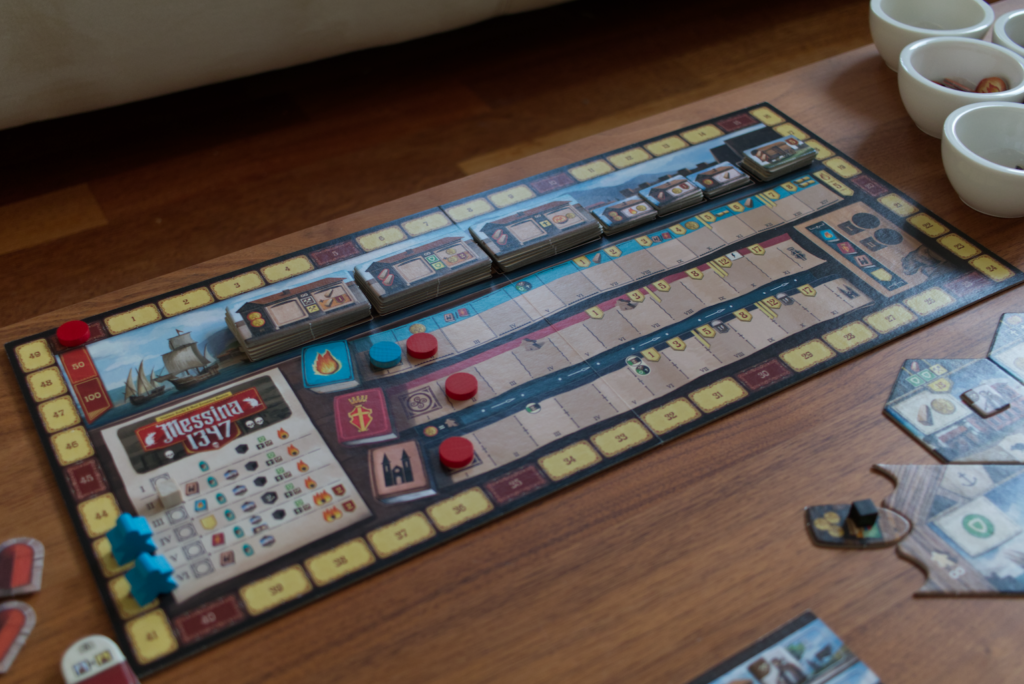
End of Round
Depending on the round, different things happen in different intensity. Your citizens do production for you, advance out of quarantine, new ships arrive, the city grows, plague and citizens are distributed. The variety is something that I under-appreciated for a while: Trying to build up your production first before fighting the plague? Well, in the last two rounds, it gets more expensive to fight it. And in the last round, no new plague tokens are put on the board. So it can quickly happen to you that you plan for a big clean up in the final round but your opponents have already removed everything and you have no chance to improve on the reputation track anymore.
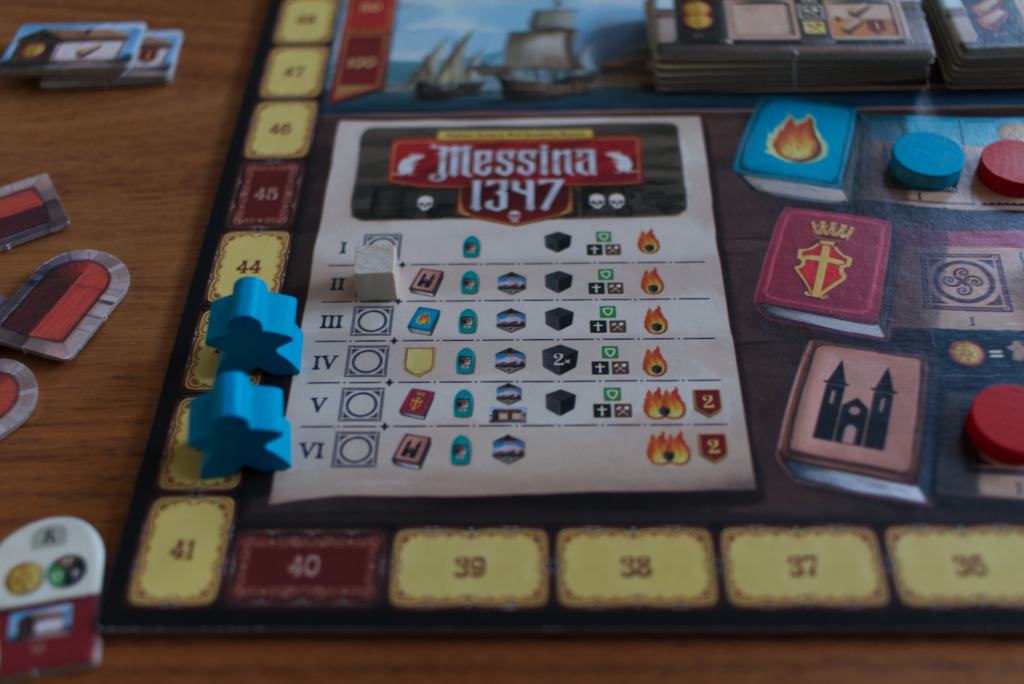
Waiting too long before rescuing citizens? Well, in the last round no new ones are placed on the board. Not gaining enough fire tokens? Well, in the fourth round double the plague tokens are placed. Depending on player count, suddenly double the amount of ships arrive, workshop buildings that produce every round are replaced with one shot buildings, fighting the plague suddenly gives you 2 VP but also costs double the amount of fire tokens, and so on… it’s no fundamental change in rules, it’s just tweaks that throw a wrench into your finely tuned engine.
Scoring
During the game, quarantine huts, workshops and track bonus allow you to gain roughly 20-30 VP of the 130/140 VP you need in a solo game. It’s not enough to win the game but enough so you cannot drop the ball on snatching up points here and there.
During final scoring, you get VP depending on your position on the three tracks (popularity is gained when fighting the plague, the other two have to be worked on via actions/bonuses and increase the number of meeples/actions you have and the strength of your overseer discs), VP for the hex fields you have repopulated with your citizens, VP for three scroll tracks (VP multipliers for certain aspects you have to level up during the game) and VP for remaining tokens. It’s a good blend: repopulating hex fields gives tons of points, but it costs you citizens, resources and an action. Advancing on the three tracks on the central board gives you powerful bonuses during game and some amount of endgame VP, but it is an effort to really get to the end of the track. Raising your scroll track multipliers also isn’t easy as it takes precious actions to do it.
A nice touch: if you do not remove plague tokens during the game, you collect (quite cute) rat tokens. At the end of the game, you don’t simply lose VP but also steps on the popularity track.
Advanced Variant and Automa
To use the advanced variant, randomly assign player colors and use the B-side of the player board. Also use the B side of the scroll track board. This introduces a slight amount of asymmetry which gives you a nice focus (e.g. I want to advance on the church track) without giving anyone a particular advantage. You can easily use those in your very first game, but having the A side makes the game easier for new/more casual players and let’s you choose your own path to victory.
The automa is a set of cardboard pieces. Draw one, place the worker meeple on that field to block it and perform some clean-up action printed on the bottom part. There isn’t much “player interaction” except that it blocks the field, removes citizens and plague token. The automa has no markers on the central board (and does not track VP) except for a marker on the popularity track. Every time it removes a plague token, it advances on the track and you get 5 VP bonus if you are not behind it at the end of the game. You win the solo game if you score 130 VP in the basic variant or 140VP in the advanced variant.
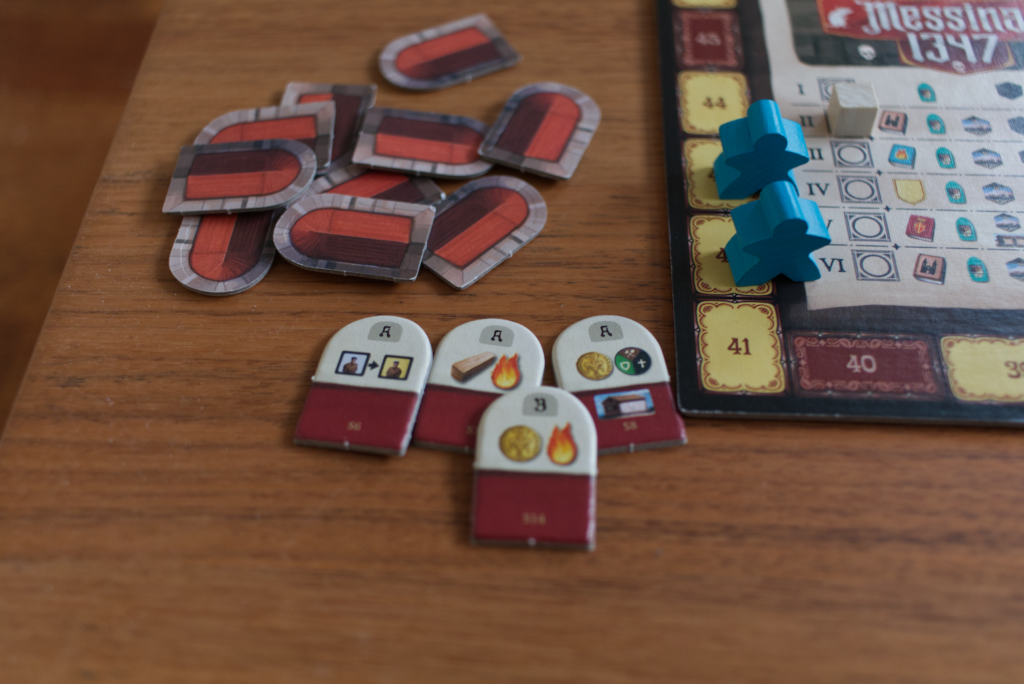
Initially, I was a bit disappointed because I like more life-like automas that feel like they have intend and that score their own VP I have to beat. However, I’ve come around to it. The automa is quick to use and sometimes really annoys because it removes a plague token you desperately had planned on removing or snatches a citizen/boat. Opposed to the solo mode in Underwater Cities, just having to beat a VP goal is less of an issue for me here. It’s less frustrating somehow, possibly because you had a good time all throughout the game and if you didn’t reach the magical number, oh well, time for another game. Maybe this time you can cut a few more corners here and there…
Conclusion
I’ve omitted a few aspects (e.g. docks, boats, …) to focus more on the general feel of the game. As I wrote in the introduction, my very first impression was a somewhat disappointed “nice, but what’s special about it”? The answer is: man, this game is astonishingly smooth! The more I play it, the more I get the impression that the authors intentionally spent a lot of time on finding the right balance between complexity and depth. Take for example the way plague tokens are placed. You might expect a Pandemic-style spreading but no, it’s a pseudo-random wheel mechanism to place them. At first I was disappointed because I imagined the plague to come in with the boats and then spread, but that only makes sense on the macro level. In Pandemic, plague spreads from city to city. In a single city, people travel around so the plague pops up unexpectedly here and there. The wheel is both a mechanism to keep things incredibly simple but thematic at the same time.
Another example: at the end of a round, all citizens on hexes with plague tokens on them are removed and discarded. At first I thought this was a missed opportunity as I imagined some Lowlands-style mechanism where the game intensifies the more citizens are killed by the plague. But the more I play Messina, the more I have the feeling there was such a prototype at some point but the authors actively decided to drop it.
And a final one: As mentioned, re-populating hex fields gives big VP at the end. It also gives you 2VP whenever someone uses the field. However, in order to re-populate it, you not only need money/wood and a special combination of citizens, you not only need to get to the right field and spend an action, no, you also need to buy one of those cursed wagons and each can be only used once per round. So you may have the best plans to gather resources and rescue citizens to repopulate half the city, but you lack either a) the number of worker meeples, b) gold to get there, c) wagons, d) resources, … or simply someone just does build there before you. Time is ticking in Messina 1347, ticking indeed…
I’m looking forward to trying this non-solo. Also there are a few aspects which initially felt like they could have been cut for further streamlining but on second thought could be another path to victory I simply haven’t taken yet. I see them as sprinkles on top of a nice solid core set of mechanisms which keep me curious.
To sum it up: Messina 1347 is a clever and appealing act of design work. I would really like to interview the authors one day and ask them about all the decisions they made on what to keep in and what to throw out. It reduces complexity without loosing depth, it introduces minor tweaks to shake up the formula from round to round, it adds just enough asymmetry, it adds spatial dependency such that performing one action might put another one out of reach during the next turn, etc. It is easy enough to just pull it out after a long day and play a round but if you want, you can build up to and trigger nice combos.
It remains to be seen how well-balanced the different paths to victory are. That will take a lot more plays. And I’m also not sure yet how long Messina will keep me coming back to it. That’s always difficult to say after a few plays. All I can say is that right now, I find myself repeatedly drawn back in because of how pleasant and enjoyable it is to play. It’s tricky and clever without being too much of an AP-inducing head scratcher. So make yourself a nice cup of tea or open a bottle of beer, put Messina 1347 to the table and simply have a good time.
Update Jan 6, 2022: Thanks for all the thumbs up! I’ve added a couple of images to help the flow of the post. If you have questions or feedback, feel free to add them in the comments or message me directly. I’ll try to answer them if I can.
Update Jan 8, 2022: I’m happy to report that non-solo play is great as well. Let’s start at the beginning: teaching the rules to others revealed that the game is more intricate than I had thought. The core mechanisms are easy to grasp but there are lots of side notes. Can a double fire-marker be used to clean up a single plague token in round 5-6? (rules read like no but Vladimir Suchy says yes). Can you move citizens between quarantine huts? (answer: no). Will the later-turn workshops produce when the worker is placed in or during the next production? (answer: immediately). It’s all manageable but don’t expect to play this with a family of casual gamers that are impatient when it comes to rule explanations.
Coming from solo play, the obvious question was how much is this multiplayer-solitaire and how much does it gain from playing with other players? First, there is turn order. In solo play, it simply changes every round between you and the automa. In multiplayer, it depends on your position on a different track each round. It is a great mechanism because you a) have a way to influence turn order and b) it gives you an added incentive to push on a particular track although it might not fit into your overall strategy. And in a game this tight, turn order has a real impact! It is definitely a plus compared to the solo mode.
I was surprised by the amount of player interaction. For new players, the game is a lot to stomach and interaction will be mostly accidental or focused on popularity track order. But that already is enough, there was definitely a competitive feel. Due to the tight economy, chances that someone else will pick that one place you desperately need are high. We had a lot of funny “why, oh why, did you pick that place?” or my favourite “why, oh why, did you remove that plague token I needed to be there?”. It’s always possible to produce a good turn, but producing a great turn hangs on a shoe string … that others can easily snap.
The downside of this is that the speed of the first few rounds is somewhat lost in the last two rounds. At the beginning of the turn, you have a plan what you want to achieve. If the player next to you picks that vital action you needed to take, you suddenly have to re-evaluate what you want to do with all the meeples in your whole turn. So you are searching for another unique opportunity to make up ground and can easily get to a state where you were thinking for 10 minutes and still have the look of desperation on your face. It’s hard to let go when you knew how much you could have achieved with your original plan.
If you have played 2-3 games of Messina 1347, it’s surprisingly easy to read the board state and take active measures. You can see which overseer movement would benefit another player the most because it’s typically the area where they have placed the most citizens. Depending on their quarantine hut upgrades, you know if they need to pick up quarantined or free citizens. Depending on the spread of plague and their supply of fire tokens, you know if you need to block something so they cannot rise on the popularity track. Figuring out which hex-fields someone is planning to repopulate is more tricky to do. Using the advanced variant also makes it easier to cross plans because you have asymmetric scroll scoring multipliers and thus can see which tracks or resources someone is likely to want to work on. But there is so much possible combo-triggering that it is difficult to completely evaluate where someone else will end up with his turn.
So thumbs up for multiplayer as well. All had a good time and right now I don’t think that the puzzle will lose it’s attraction with repeated play. I would say it’s in a category with Grand Austria Hotel for me: Limited number of turns and actions, trying to find ways of squeezing out just that little bit of extra effect, still always having the feeling of accomplishment. That vital last part is what – for me personally – is missing in Lost Ruins of Arnak or Imperial Settlers which I like to call hyper-optimization-turn-extending games. Messina 1347 rewards me more with a warm feeling of “I built this up” and the long lasting question which twist I missed or corner didn’t cut for ending up with so few points in the end.

Thank you for providing a well thought out review. I love that you followed up with your thoughts after multiple plays and on the multiplayer experience as well while comparing it to the solo game. I wish more reviews would do that. Great job!
Thanks! When I started this project, I took some time to think about what I found missing in existing reviews and what I might contribute. This longer term perspective is one of those aspects and the reason why most of my discussions are “first impressions” although I typically have gotten in a whole bunch of plays at that point. I feel a full review should be something where I’m definitely sure I know the long term perspective and for first impressions, I like to come back and add those updates instead.